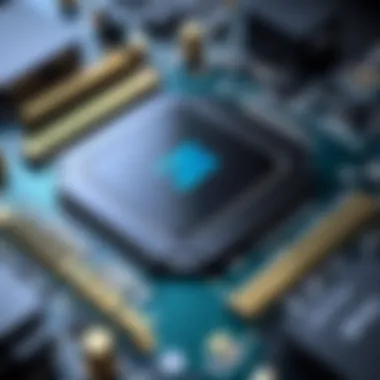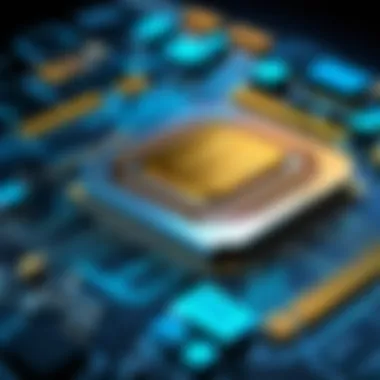Understanding CPU Applications: An In-Depth Guide


Intro
In the realm of computing, the Central Processing Unit (CPU) stands as the heart of any digital device. Its fundamental role is to process instructions and manage tasks, making it indispensable in various applications. Understanding how CPUs operate and their significance is crucial for anyone involved in technology, whether as a hobbyist or a professional.
This guide aims to clarify the complexity surrounding CPU applications. From the architecture that defines their capabilities to the myriad of tasks they handle, this article will explore each facet. Additionally, we will highlight the evolution of CPU technology and its impact on everyday devices. By the end of this article, readers will have a comprehensive understanding of CPUs and their vital function in modern technology.
Key Features
When considering the relevance of CPUs in computing, it is essential to explore their key features. These include:
- Architecture: This refers to the design and layout of the CPU. Different architectures yield varying performance and energy efficiencies.
- Processing Power: Measured in gigahertz (GHz), this indicates how many cycles per second the CPU can process. Higher GHz often equates to better performance.
- Core Count: Modern CPUs have multiple cores. Each core can handle its thread, enabling more tasks to be processed simultaneously.
- Cache Memory: This is a smaller, faster type of volatile memory that provides high-speed data access to the CPU. A larger cache typically enhances performance by reducing latency.
These features play a crucial role in determining the capabilities of a CPU, as well as its suitability for specific applications.
Architecture Types
Understanding the various architectures is crucial in grasping the performance and application scope of CPUs.
- x86 Architecture: This is one of the most widely used architectures, prominent in personal computers and servers. It supports a broad range of applications, from gaming to professional software.
- ARM Architecture: Commonly found in mobile devices and embedded systems, ARM architecture is known for its power efficiency.
- RISC (Reduced Instruction Set Computing): This architecture focuses on a small set of simple instructions, optimizing performance for specific tasks.
- Strengths: High compatibility with software and hardware, extensive support for legacy programs.
- Strengths: Reduced energy consumption, optimized for portable devices.
- Strengths: Efficient execution allows for faster processing of tasks.
Each architecture has its specific use cases and advantages, influencing the choice of CPUs in various devices.
Product Specifications
When purchasing or assessing CPUs, the specifications play a significant role. Key product specifications include:
- Technical Specifications: These encompass core count, clock speed, thermal design power (TDP), and cache size. Notably, higher specifications often result in better performance but might also lead to increased power consumption.
- Compatibility and Connectivity: Ensure that the CPU is compatible with the motherboard and peripherals. Additionally, modern CPUs may offer features like integrated graphics and support for multiple GPU setups.
Understanding these specifications guides informed decisions, whether upgrading existing hardware or building a new system.
"The architecture of a CPU not only dictates its performance but also its ability to support modern applications and technologies."
CPU Applications Explained
Cpu applications play a crucial role in computing today. As technology advances, CPUs are central to how we use and interact with devices. Understanding these applications means comprehending how processors carry out tasks that users depend on daily. From handling basic functions to running complex applications, CPUs are foundational components in modern technology.
Definition and Scope
CPUs, or Central Processing Units, are often likened to the brains of computers. They execute instructions from programs, making them indispensable for all computing tasks. The scope of CPU applications encompasses both general-purpose and specialized uses. General-purpose CPUs power personal computers and laptops, while specialized CPUs are designed for tasks like graphic rendering, gaming, or embedded systems.
The definition of CPU applications can be extended to how these processors interact with hardware and software, enabling features like multitasking and resource management. They are critical in determining system performance, efficiency, and responsiveness. Knowledge about this topic is especially important for tech-savvy individuals who aim to make informed decisions about their computing needs.
Historical Context
To fully appreciate CPU applications, one must consider their historical evolution. The first CPUs began with simple, single-purpose designs in the early days of computing. These early processors were limited in functionality and performance. The introduction of microprocessors in the 1970s marked a pivotal shift. These compact chips combined the CPU's functionality into one unit, paving the way for personal computers.
In the following decades, advancements in technology led to the rise of multiprocessor systems and multi-core CPUs, enhancing performance significantly. Modern CPUs now integrate features like hyper-threading and energy-efficient designs. This historical development illustrates not only technological progress but also changing user needs. Understanding how CPU applications have evolved enhances awareness of future possibilities, such as increasingly powerful and efficient processors.
Understanding CPU Architecture


Understanding CPU architecture is essential as it lays the groundwork for how a computer system operates. Each CPU can be viewed as the brain of the computer, executing instructions that allow software to run and perform tasks. A well-designed architecture can improve performance, efficiency, and overall system capability. Additionally, it informs users about the limitations and advantages of various CPUs.
In this section, we will explore the core elements that constitute CPU architecture, the process of information handling within CPUs, and the differences across various models.
Basic Components of a CPU
The basic components of a CPU include the ALU (Arithmetic Logic Unit), the control unit, and registers. The ALU is responsible for performing arithmetic calculations and logic operations. The control unit orchestrates the flow of instructions and data within the CPU and between the CPU and other components. Registers are small storage locations within the CPU that hold data temporarily during processing.
Understanding these components helps in identifying how tasks are executed. For example, the performance of a CPU can be significantly impacted by the size and speed of its registers. Larger and faster registers can improve data access speed, allowing programs to run more efficiently.
How CPUs Process Information
CPUs process information following a set of predefined instructions, often represented as machine code. This process includes fetching the instruction from memory, decoding it to understand what action is needed, executing the instruction, and finally storing the result back into memory or registers.
The speed at which a CPU can perform these steps is critical for overall system performance. A CPU's instruction set architecture determines which operations it can perform and influences how software interacts with the hardware.
This processing cycle, also known as the instruction cycle, is what allows software applications to function smoothly. It is important for individuals to recognize that any inefficiency in this area can lead to slowdowns, affecting productivity.
Differences in Architecture
Different CPU architectures are designed to meet diverse computing needs. For instance, CISC (Complex Instruction Set Computing) architectures, like those employed in Intel processors, are built to execute complex instructions in fewer steps. This can be beneficial for projects requiring intricate calculations.
Conversely, RISC (Reduced Instruction Set Computing) architectures, found in ARM processors, operate on a smaller set of instructions. This can lead to faster execution as each instruction is designed to be completed in a single cycle.
In choosing a CPU, one must consider factors such as workload type and desired efficiency. For tasks demanding quick response times, a RISC architecture may be more suitable, whereas CISC could be advantageous for executing specialized applications.
Understanding these components and their functions not only informs purchasing decisions but also enhances the user's ability to optimize systems for specific tasks.
Types of CPU Applications
Understanding the types of CPU applications is essential for appreciating their role in modern computing. This section aims to dissect the various forms of CPU applications, highlighting their unique benefits and considerations. CPUs are not merely mechanical devices; they are sophisticated components that adapt to diverse computing needs. The importance lies in how these applications enhance performance, optimize resource utilization, and ultimately influence user experience in various device categories.
General-Purpose CPU Applications
General-purpose CPUs are designed to handle a wide range of tasks. They can run various software and applications, making them versatile for different computing environments. These CPUs are found in personal computers, servers, and many electronic devices. Their ability to perform multiple tasks concurrently provides significant advantages.
These advantages include:
- Flexibility: General-purpose CPUs can run any operating system and execute a variety of applications.
- Wide Compatibility: They are universally compatible with different software types, ranging from productivity tools to advanced gaming engines.
- Cost-Effectiveness: Their mass production leads to economies of scale, making them more affordable for consumers.
They typically balance performance with power consumption, catering to both casual users and professionals. This adaptability makes them suitable for everyday tasks, such as web browsing, video conferencing, and even programming.
Specialized CPU Applications
Specialized CPUs focus on specific tasks or processes. These processors are optimized for performance in particular areas, like graphic processing or data calculation. Examples include graphic processing units (GPUs) used in gaming and deep learning applications.
The benefits of specialized CPU applications are pronounced:
- Optimized Performance: They are engineered to excel in their designated tasks, resulting in quicker response times and better overall efficiency.
- Energy Efficiency: Specialized CPUs often use less power compared to general-purpose CPUs for specific tasks, thereby extending the battery life of devices.
- Enhanced Capabilities: They enable applications that require intensive calculations, such as machine learning and high-end graphics rendering.
While they may lack the versatility of general-purpose processors, the advantages of using specialized applications make them necessary for modern technology demands.
Embedded Systems
Embedded systems represent yet another branch of CPU applications. These systems integrate CPUs into devices dedicated to specific functions, often with real-time computing constraints. Examples of embedded systems include microcontrollers in household appliances, automotive electronics, and medical devices.
Key aspects of embedded systems include:


- Dedicated Functionality: Embedded systems are designed for particular tasks, such as controlling a washing machine or managing vehicle navigation systems.
- Reliability and Stability: They often prioritize stability and efficiency, given their application in critical environments.
- Cost and Size Efficiency: These systems are typically compact and cost-effective, making them suitable for mass production.
In summary, embedded systems illustrate how CPU applications can be tailored to perform specific roles within larger systems, thereby making technology more efficient and user-friendly.
"Understanding the type of CPU applications you need is crucial for selecting the right processor for your devices."
To conclude, the types of CPU applications, from general-purpose to specialized and embedded systems, serve critical roles in computing. Recognizing these different applications helps guide decisions when choosing CPUs for personal or professional use.
Performance Metrics for CPU Applications
In the evaluation of CPU applications, performance metrics serve as crucial indicators of a system’s capabilities. Understanding these metrics allows users to make informed decisions about hardware, software, and their overall computing environment. It becomes essential to dissect how these metrics impact functionality and usability.
Key aspects to consider include:
- Benchmarking: Performance metrics often rely on benchmarks, which provide standardized measurements in various scenarios. This includes tasks like processing speed and handling instructions per cycle. Evaluating different benchmarks helps users understand which CPU performs better under specific workloads.
- Real-World Scenarios: Metrics must reflect end-user experiences. A CPU may perform flawlessly in controlled environments, yet struggles under realistic operating conditions. Hence, aligning the metrics with actual use cases is vital.
- Future-Proofing: As technology evolves, understanding metrics ensures that current investments will serve future demands. CPUs with better metrics tend to withstand the test of time as newer software and applications require more resources.
Performance metrics encompass various elements that contribute to the overall effectiveness of CPU applications. The following sections will delve deeper into the specific metrics that are vital for assessing CPU performance.
Processing Speed
Processing speed is often the most discussed metric in CPU performance. It indicates how quickly a CPU can execute tasks. Measured in gigahertz (GHz), higher numbers generally suggest faster processing capabilities. However, speed alone does not determine performance. Factors like instruction sets and architecture also play significant roles. Users often benefit from understanding:
- Clock Speed: Refers to the number of cycles a CPU can perform per second. Nevertheless, this number should be analyzed in concert with other features like core count and architecture.
- Core Count: Modern CPUs typically have multiple cores allowing concurrent processing. A CPU running at a lower clock speed but with more cores can outperform a faster CPU under multitasking scenarios.
Power Efficiency
In today’s technology landscape, power efficiency is more critical than ever. This metric measures how effectively a CPU converts power into performance. Components that require excessive power can lead to higher operational costs and environmental impact. When evaluating power efficiency, consider:
- Performance per Watt: This ratio indicates how much computing power is achieved for each watt consumed. Efficient CPUs minimize energy loss.
- Heat Generation: Processors that generate less heat tend to require less cooling, which in turn saves energy and enhances lifespan. Factors such as thermal design power (TDP) give insights into a CPU's cooling requirements and overall efficiency.
Thermal Management
Thermal management describes how well a CPU handles heat generated during operation. High temperatures can adversely affect performance and longevity. An effective thermal management system is thus essential. Key considerations include:
- Cooling Solutions: Different CPUs come with varying cooling options. Air cooling, liquid cooling, or even advanced solutions like phase change cooling can have impacts on thermal performance.
- Thermal Throttling: This is a mechanism where a CPU slows down to prevent overheating. Understanding how processors manage thermal thresholds is crucial for performance assessment under extensive workloads.
"Investing in efficient cooling solutions can prolong the lifespan of your CPU while maintaining optimal performance."
Integrating the above metrics will furnish a more complete picture of CPU applications and their performance. Users need to understand that performance metrics are not standalone attributes but interlinked facets that together enhance an application's operational capabilities.
Software Interactions with CPU Applications
The interplay between software and CPU applications forms a crucial part of a computer's functionality. Understanding this relationship enhances our comprehension of computing as a whole. Every action a user performs on a computer relies on this synergy. The effectiveness of software influences the computational capabilities of the CPU. Therefore, recognizing how software interacts with CPU applications is important for optimizing both performance and user experience.
Operating Systems and CPU Collaboration
Operating systems are fundamental to computing environments. They act as a bridge between the end user and the hardware components of the computer, including the CPU. The operating system manages system resources and provides an interface for applications to communicate with the CPU efficiently. This collaboration is essential because it determines how well tasks are executed and how resources are allocated.
In essence, an operating system optimally schedules tasks for the CPU, ensuring that the processor is not overloaded. This process involves prioritizing tasks based on urgency and resource requirements.
- Task Scheduling: Operating systems implement algorithms for scheduling tasks. Different operating systems use distinct mechanisms, such as round-robin scheduling or priority scheduling, to manage requests sent to the CPU.
- Resource Management: The operating system oversees memory allocation, handling both hardware and software needs. This helps prevent CPU bottlenecks when multiple processes need simultaneous access to resources.
- System Calls: Application interactions with hardware components utilize system calls managed by the operating system. This function translates application requests into commands the CPU can process, allowing for reliable execution of tasks.
Application Programming Interfaces
Application Programming Interfaces (APIs) serve as vital tools in facilitating software interactions with CPU applications. APIs provide predefined protocols and tools for building software applications, simplifying coding by providing building blocks. They enhance compatibility and interaction between applications and operating systems, which ultimately affects CPU performance.
Using APIs, developers can create software that effectively communicates with the CPU without needing to manage hardware details. Here are some key aspects regarding APIs and their interaction with CPU applications:


- Efficiency Gains: APIs often abstract complex processes, enabling faster development. This leads to quicker releases and more robust applications that efficiently utilize CPU resources.
- Cross-Platform Capabilities: Many APIs support multiple operating systems. This ensures that applications function across diverse platforms, maximizing the reach and utility of software built for a specific CPU architecture.
- Standardization: APIs introduce consistency in software development. Developers follow specific protocols, which leads to predictable performance and behavior in applications. Each API call interacts with the CPU in a defined manner, contributing to streamlined operations.
"A well-designed API simplifies the development process, directly influencing the efficiency of CPU applications."
Emerging Trends in CPU Technology
The landscape of CPU technology is constantly evolving. This section explores emerging trends that define the future of computing. These trends highlight how CPUs are adapting to meet new challenges and opportunities. By understanding these advancements, one can grasp the potential impacts on various sectors, including enterprise computing, consumer electronics, and scientific research.
Quantum Computing on the Horizon
Quantum computing represents a significant shift in how computers process information. Traditional CPUs operate using binary bits, which can either be 0 or 1. Quantum computers, however, utilize quantum bits, or qubits, that can exist in multiple states simultaneously. This property allows quantum systems to perform complex calculations at unprecedented speeds.
The implications of quantum computing are profound. For instance, industries such as cryptography could be revolutionized by quantum algorithms that break conventional encryption methods. Additionally, drug discovery and materials science stand to benefit from simulations only possible in quantum realms.
However, developing functional quantum processors remains a challenge. Factors such as error rates, qubit coherence times, and scalability must be addressed before quantum computing becomes mainstream. As research continues, we may witness breakthrough technologies that could redefine computational limits.
"Quantum computing may change the course of technological development, pushing beyond what we currently regard as possible."
Artificial Intelligence Applications
The integration of Artificial Intelligence (AI) with CPU technology is reshaping applications across many fields. Modern CPUs increasingly incorporate specialized architectures to accelerate AI tasks, such as machine learning and neural network processing. For example, processors designed by NVIDIA, such as the A100 Tensor Core GPU, optimize performance for AI workloads.
High-performance CPUs now leverage parallel processing capabilities, enabling them to handle vast data sets efficiently. This efficiency enhances real-time decision-making by facilitating predictive analytics and automated systems. Organizations can streamline operations and improve services in sectors like finance, healthcare, and transportation.
Moreover, the trend towards AI-optimized CPUs raises new considerations regarding power efficiency and thermal management. As AI applications demand more resources, balancing energy consumption and performance becomes paramount.
Choosing the Right CPU for Your Needs
Selecting the appropriate CPU can significantly affect the performance of your computing systems. Whether you are a gamer, a content creator, or a business professional, understanding your specific needs is crucial. Not all CPUs serve the same function. Therefore, thoroughly evaluating your requirements can save you time and money while providing an optimal experience.
Assessing Your Requirements
Before committing to a CPU, consider what tasks you will perform. Different applications may demand varied processing power. For instance, gaming and video editing require higher clock speeds and multiple cores. On the other hand, daily tasks like web browsing and document editing may not need extensive resources.
- Usage Type: Understand your primary activities. Are you gaming, doing light office work, or engaging in intensive software development?
- Multitasking Needs: Assess if you often run several applications simultaneously. This might require more cores and threads.
- Future Considerations: Think about your future needs. Will you upgrade software or change your computing tasks? Anticipating these aspects helps in selecting a CPU with longevity.
Getting the right CPU involves finding the right balances and requirements for your unique situation.
Balancing Performance and Cost
Finding an ideal CPU also involves weighing performance against financial constraints. High-performance CPUs do exist, but they come at a price. The decision often comes down to how much you are willing to invest for better performance.
- Budget Allocation: Determine how much you are ready to spend. High-end processors such as the Intel Core i9 or AMD Ryzen 9 may seem appealing but check if their performance gain justifies the price.
- Performance Metrics: Analyze benchmarks and performance metrics to validate any CPU's capabilities. Review processing speed, core counts and thermal design power before making decisions.
- Upgrade Path: Consider potential upgrades. Sometimes, spending slightly more now can extend the life of your system and provide better future performance.
Future Developments in CPU Applications
Understanding future developments in CPU applications is essential for grasping where technology is headed. As computing needs evolve, so too does the architecture and design of CPUs. This section delves into anticipated innovations and their potential impact on consumer technology, shedding light on how these changes may enhance performance, efficiency, and user experience.
Anticipated Innovations
The landscape of CPU technology is ever-changing, driven by the need for faster processing and increased efficiency. Innovations on the horizon include:
- Integration of AI Capabilities: Future CPUs may incorporate artificial intelligence directly into their cores. This shift allows for smarter processing tasks, reducing latency and enhancing real-time data analysis.
- 3D Chip Stacking: Utilizing layers of chips increases density without expanding the footprint. This technology promises to provide superior performance and power efficiency by minimizing the distance data must travel within a chip.
- Arm Architecture Expansion: More devices are adopting the Arm architecture thanks to its energy-efficient designs. As this becomes commonplace, CPUs will become better suited for mobile devices, IoT, and other specialized applications.
- Advancements in Semiconductor Materials: The exploration of materials beyond silicon, such as graphene and carbon nanotubes, may lead to CPUs that are faster and consume less power.
"The next generation of CPUs is set to redefine how we interact with technology, making our devices faster and smarter."
Impact on Consumer Technology
The implications of these anticipated innovations for consumer technology cannot be overstated. As CPUs become more powerful and efficient, several critical areas will be impacted:
- Enhanced User Experience: With processors able to handle more tasks simultaneously, applications will run smoother. This impacts everything from gaming to multitasking productivity software.
- Improved Energy Efficiency: Innovations such as 3D chip stacking and new materials can lead to significant reductions in energy consumption, benefiting not only the environment but also lowering operational costs for consumers and businesses alike.
- Expansion of Smart Devices: As CPUs integrate AI, smart home devices and appliances will become increasingly autonomous and responsive, leading to more seamless user interactions.
- Growth in IoT Applications: As processing capabilities expand, so will applications in the Internet of Things. Devices will be able to perform complex tasks locally rather than relying on cloud computing, enhancing responsiveness and security.
The future of CPU applications is promising, with innovations set to significantly enhance computing capabilities. As consumers, it is essential to stay informed about these changes and how they may revolutionize our daily technology interactions.



